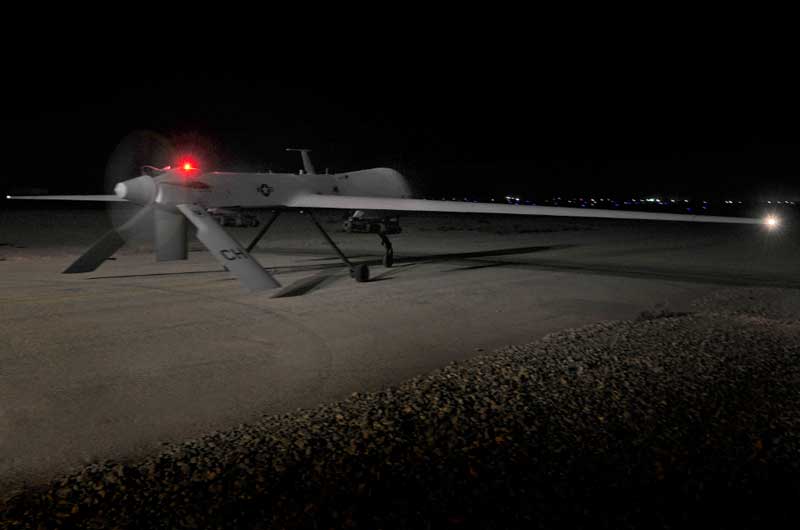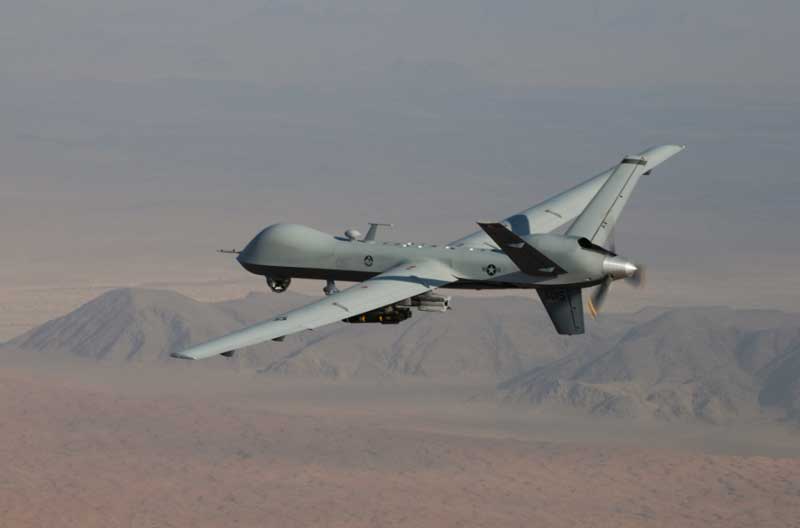
01/02/2011 – In recent years, the main form of U.S. military operation in Pakistan, Yemen, and other terrorist havens has been the missiles launched from Unmanned Aerial Vehicles (UAVs). These remotely piloted armed drones are widely known to be operated by the Central Intelligence Agency (CIA) and the U.S. Department of Defense (DoD). They launch rapid missile attacks on high-value terrorist targets, selecting their targets on the basis of human and signal intelligence.
Although the UAVs often operate with the consent of the host government, who seek to direct the attacks against their violent domestic opponents and prefer the drone strikes to a major foreign military presence or other foreign footprints, they rarely enjoy the popular backing of the people of the bombarded nation.
The Predator UAV was first equipped with a Hellfire missile in 2001. It then used this weapon to kill terrorist Qaid Salim Sinan al-Harithi in Yemen on November 3, 2002. Since then, the most widely publicized attacks have been in Pakistan. Like Yemen, Pakistan is another country where a major American military ground presence would be controversial.
According to various media and think tank reports, CIA and DoD drones such as the Predator and Reaper UAVs armed with Hellfire missiles have killed hundreds of people in northwest Pakistan in recent years. These numbers have reportedly surged in 2010 as the Obama administration has been seeking to complement the increase in U.S. combat troops inside Afghanistan with intensified operations in the Taliban sanctuary in neighboring Pakistan.
 An MQ-1 Predator Unmanned Aerial Vehicle launches for a night flight mission over southeastern Iraq, July 29, 2009. The aircraft serves in a surveillance and reconnaissance role but is also capable of firing two AGM-114 Hellfire missiles (Credit: 407th Expeditionary Group Public Affairs, 8/15/09)
An MQ-1 Predator Unmanned Aerial Vehicle launches for a night flight mission over southeastern Iraq, July 29, 2009. The aircraft serves in a surveillance and reconnaissance role but is also capable of firing two AGM-114 Hellfire missiles (Credit: 407th Expeditionary Group Public Affairs, 8/15/09)
This trend will likely continue as the Administration strives to meet its metrics for success by the time its major review of the Afghan War is complete at the end of this year. The discovery that Faisal Shahzad, the failed May 1 Times Square bomber, had received terrorist training in Pakistan, has exacerbated concerns that Pakistan has replaced Afghanistan as the main state sanctuary of international terrorism.
The options and dynamics of using drones are also discussed in an accompanying piece by Robbin Laird.
The drone attacks are controversial but are still considered the best of a bad set of options by both U.S. and Pakistani officials.
On the negative side of the ledger, human rights groups criticize them as extrajudicial killings since the suspected terrorist is killed outright rather than given a trial. Since U.S. officials decline to comment on the UAV operations in Pakistan, the Taliban and others are free to exaggerate to the media the number of innocent victims they cause. Polls show that the UAV attacks are not popular with the Pakistani people, though the inhabitants of the tribal areas who are oppressed by the foreign Islamist radicals are not really free to express their opinion for fear of retaliation. Experts believe that the number of civilian casualties has declined in recent years due to improved intelligence, stricter rules of engagement, and the use of less powerful missile warheads.
Still, the UAVs cannot capture terrorist suspects for further interrogation and cannot acquire other sources of intelligence that might reside at the sites they attack, such as revealing documents and computer files. Confirming deaths is difficult due to the absence of credible witnesses or physical evidence at the site. Several prominent targets have been proclaimed dead only to turn up alive later.
Members of the Tanzeem-e-Islami, a Pakistani religious group often described as the core of the Pakistani Taliban, also cite the continuing UAV strikes to justify their terrorist campaign against the Pakistanis living outside the tribal zone. They describe their bombings, which have killed thousands of civilians as well as Pakistani security forces, as retaliation for the Pakistani government’s allowing the UAVs to operate.
Although most Pakistanis have little sympathy for the militants, polls indicate that they blame the Americans and their own government for antagonizing the Islamists, whose operations had originally been focused on the Afghan-Pakistan border region.
The drone strikes have also led the jihadists to kill many other tribal inhabitants whom they suspect of providing targeting data to the Americans or their Pakistani partners.
A more recent development has been that the Pakistani Taliban has cited the U.S. drone attacks as the reason why they have started to conduct terrorist bombings against European and American targets, including the successful attack on a CIA operations center in Khost province in late 2009 and the failed Times Square bombing attempt on May 1, 2010.
A Tahreek-e-Taliban spokesman also said that the recent torching of the trucks delivering fuel through Pakistan to the NATO forces in Afghanistan would increase for every drone attack on their members.
In terms of their advantages, the UAVs are very useful for striking terrorist targets in remote locations, especially those that lack air defenses and must rely on concealment and other passive defenses. Modern drones can remain airborne for more than 24 hours, giving them the opportunity to strike even fleeting targets more rapidly than it would take a manned warplane to reach the target.
UAVs cost substantially less to acquire and operate than manned warplanes and helicopters, but these lower acquisition costs must be weighed against the greater losses typically experienced by these aircraft, and the higher cost of most strike versus reconnaissance drones.
The larger Reaper drones are much more expensive than simpler ISR drones, so cost advantages over manned systems are much reduced. Indeed, as Robbin Laird will argue, there are manned options which might be considerable cheaper to operate than drones, when the human support components supporting the drones are taken into account.
But there are other advantages of a remotely piloted aircraft. For example, pilots and crew are not lost when a UAV crashes or is shot down. Yet, a UAV equipped with Hellfire ground-attack missiles gives an unmanned drone a strike capability comparable to that of an Apache helicopter gunship.
The larger MQ-9 Reaper drones can carry as many as 16 Hellfire missiles, two GBU-12 Paveway II laser-guided bombs, or the 500 pound variant of the GBU-38 500 Joint Direct Attack Munition.
 The MQ-9 Reaper is a medium-to-high altitude, long endurance unmanned aircraft system. The Reaper’s primary missions are close air support, air interdiction, and intelligence, surveillance and reconnaissance, or ISR. It acts as a Joint Forces Air Component Commander-owned theater asset for reconnaissance, surveillance and target acquisition in support of the Joint Forces Commander. (Credit: USAF, http://www.af.mil/information/factsheets/factsheet.asp?id=6405)
The MQ-9 Reaper is a medium-to-high altitude, long endurance unmanned aircraft system. The Reaper’s primary missions are close air support, air interdiction, and intelligence, surveillance and reconnaissance, or ISR. It acts as a Joint Forces Air Component Commander-owned theater asset for reconnaissance, surveillance and target acquisition in support of the Joint Forces Commander. (Credit: USAF, http://www.af.mil/information/factsheets/factsheet.asp?id=6405)
In addition, the drones have the benefit of stirring up suspicions and tensions in their target areas since the terrorists suspect the local inhabitants as well as rival terrorists of providing information on which targets to attack. The terrorists then get into fights with the locals and one another, which can further tempt the residents and the terrorists to inform on them so that the drones might take out their opponents.
Another advantage of the U.S. drone strikes is that the “receiving” governments often come to support them more since their range of targets has been extended from al-Qaeda and other international terrorists to local militants fighting the host government.
In Pakistan, the drones have killed Pakistani Taliban leaders who have been waging a campaign of terrorism against the Pakistani government and committing mass atrocities against Pakistani civilians. UAV-launched missiles have reportedly killed several anti-Islamabad guerrilla leaders.
In fact, media reports say that the drones are launched from bases inside Pakistan and used against certain targets identified by Pakistani intelligence. Although the Pakistani Taliban cite the drone strikes as the reason for their attacks on the Pakistani government, Pakistani civilians, and now civilians in NATO cities, it is unlikely that an end to the UAV strikes would lead the terrorists to curtail their operations.
Perhaps the most important argument in favor of using UAV strikes in northwest Pakistan and other terrorist havens is that alternative options are typically worse.
The Pakistani military has made clear that it is neither willing nor capable of repressing the terrorists in the tribal regions. Although the controversial ceasefire accords Islamabad earlier negotiated with tribal leaders have formally collapsed, the Pakistani Army has repeatedly postponed announced plans to occupy North Waziristan, which is where the Afghan insurgents and the foreign fighters supporting them and al-Qaeda are concentrated.
Such a move that would meet fierce resistance from the region’s population, which has traditionally enjoyed extensive autonomy. The recent massive floods have also forced the military to divert its assets to humanitarian purposes, especially helping the more than ten million displaced people driven from their homes.
But the main reason for their not attacking the Afghan Taliban or its foreign allies based in Pakistan’s tribal areas is that doing so would result in their joining the Pakistani Taliban in its vicious fight with the Islamabad government.
Yet, sending in U.S. combat troops on recurring raids or a protracted occupation of Pakistani territory would provoke widespread outrage in Pakistan and perhaps in other countries as well since the UN Security Council mandate for the NATO-led International Security Assistance Force (ISAF) in Afghanistan only authorizes military operations in Pakistan.
On the one known occasion when U.S. Special Forces actually conducted a ground assault in the tribal areas in 2008, the Pakistanis reacted furiously. On September 3, 2008, a U.S. Special Forces team attacked a suspected terrorist base in Pakistan’s South Waziristan region, killing over a dozen people. These actions evoked strong Pakistani protests. Army Chief of Staff Gen. Ashfaq Kayani, who before November 2007 had led Pakistan’s Inter-Services Intelligence (ISI), issued a written statement denying that “any agreement or understanding [existed] with the coalition forces” [in Afghanistan] allowing them to strike inside Pakistan.” The general pledged to defend Pakistan’s sovereignty and territorial integrity “at all cost.” Prime Minister Yousaf Raza Gilani and President Asif Ali Zardari also criticized the U.S. ground operation on Pakistani territory. On September 16, 2008, the Pakistani army announced it would shoot any U.S. forces attempting to cross the Afghan-Pakistan border.
On several occasions since then, Pakistani troops and militia have fired at what they believed to be American helicopters flying from Afghanistan to deploy Special Forces on their territory, though there is no conclusive evidence that the U.S. military has ever attempted another large-scale commando raid in Pakistan after the September 2008 incident.
Further large-scale U.S. military operations into Pakistan could easily rally popular support behind the Taliban and al-Qaeda. It might even precipitate the collapse of the Islambad government and its replacement by a regime in nuclear-armed Pakistan that is less friendly to Washington.
Given these alternatives, continuing the drone strikes appears to be the best of the limited options available to deal with a core problem, giving sanctuary to terrorists striking US and coalition forces in Afghanistan and beyond.

